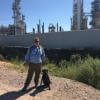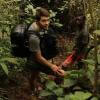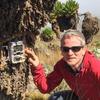BearID Featured: Artificial Intelligence & Other New Technology In Bear Research
1 July 2021 12:00am
Discover new services to improve camera traps' user experience!
24 June 2021 9:09am
In The News....
22 June 2021 1:05am
Training and usage of detection dogs to better understand bumble bee nesting habitat
19 June 2021 6:12pm
Wildlabs ML course group study
3 March 2021 4:45am
18 June 2021 11:44am
Hey Neelang,
Would love to join in on the Slack if you folks are still active. I'm thinking of taking up related courses as well.
Cheers.
19 June 2021 3:22am
Hi
I'd be interested too, but as a very green newb would I be able to follow or would another group/course be more appropriate to establish some background first.
cheers
19 June 2021 4:46am
Shoot me your e-mail! We're looking at starting a new course soon if there's enough interest.
WILDLABS Journal Club: edna vs camera traps, Wombot, Drones & killer whales
18 June 2021 4:37pm
18 June 2021 4:38pm
Read more:
-
eDNA sampled from stream networks correlates with camera trap detection rates of terrestrial mammals (2020) https://doi.org/10.1038/s41598-021-90598-5
-
Other related resources:
-
eBioAtlas: partnership between NatureMetrics and IUCN to rapidly create a global atlas of the world's freshwater biodiversity using eDNA https://ebioatlas.org/
-
WILDLABS eDNA virtual meetup talks: https://www.youtube.com/playlist?list=PLWcz3iwCnCqSyyZh7Wc3pbvtmJ-4CJcLt
-
Industry guidelines: https://www.naturemetrics.co.uk/2021/05/11/industry-brief-edna-to-manage-biodiversity-risk/
-
-
WomBot: an exploratory robot for monitoring wombat burrows: https://link.springer.com/article/10.1007/s42452-021-04595-4 -
SNAPSHOT USA 2019: a coordinated national camera trap survey of the United States : https://doi.org/10.1002/ecy.3353 -
Studying Killer Whale Behaviour with Drones
Ecognize: A platform for environmental and conservation issue reporting
8 April 2021 11:32pm
23 April 2021 6:17pm
Great initiative. Very detailed and many features. Wondering how nothing like this exists yet. One thing I'm thinking of is privacy. For many folks on the front line that I know (many of which indigenous persons) posting anyting that would be traceable to them in any way would be a real risk. I probably didn't read carefully enough sorry.
Theun Amsterdam
29 April 2021 2:42pm
I definitely think it's a great idea! I think some of the reasons there are country-by-country versions of initiatives like this are because of country-specific laws, regulations, privacy restrictions, level of enforcement, etc. There is also the issue of multi-national organizations such as WWF, WCS, FFI, etc. who may be working in some areas alongside local, community-led initiatives. You'd just want to be careful that there was equitable distribution of reports. On that note, internet access and smartphones may not be available in many places globally. I work in Madagascar and this would definitely be a problem. Perhaps allowing some sort of retroactive reporting, so someone who saw something but didn't have internet could at least report it the following week when they are back at a research station or town, for example.
I would worry too about the users reporting illegal activity and what specific security protections are in place to ensure any personally-identifiable information cannot be leaked. It might be worth thinking about how those engaging in the illegal activities themselves may try to weaponize an app like this, e.g., a large-scale mining operation reporting individuals from the community for cutting down trees (the scale of one versus the other is very different, but company-backed illegal activity will have more resources than an indigenous tribe, for example). Given how corrupt officials in different goverment agencies help perpetuate shady business dealings, there could be targeted or inequitable enforcement based on reports like this.
I would recommend reaching out to folks specifically embedded in this space, such as the people at TRAFFIC, TRACE (wildlife forensics), etc. The folks at SMART will likely have good ideas, and already have some of the functionality you're describing (albeit focused on rangers and park officials rather than the general public at large).
18 June 2021 11:54am
Hi writer (I didn't get your name ;-),
if you like we can talk for 30min or so to review your solution. There are a number of them out there, including our Cluey Data Collector & Tracking app.
The main things that we wanted to solve was:
- ease to start a project (without requiring the user to understand things like data-models etc.)
- seamless integration with other data sources and (realtime) analytical functions to help rangers optimize patrols etc.
- ease to share observations
- ease to combine/aggregate project
Would be great to share some ideas and see if we can help each other,
Best,
Jan Kees
Software/Programme for counting objects in a photo
5 March 2019 12:04am
5 March 2019 6:14am
Hi Wilson, Similar product we are creating at https://aivi.in . We are focused on audio, image, vedio based intelligent and based out of Bangalore,India. Currently implementing this solution( Computer vision, IoT , Cloud , Intelligent) for one of santuary in India to detect poachers and animals
Attaching idea snap that we are implementing. Intellgence Dashboard provides all related details ( Count etc.) This is just driven by IoT enabled camera and Mobile App for plug and play solution
28 March 2019 9:22am
I'd highly suggest going with a pre-built service like AWS Rekognition or Google Vision, as their models are already trained with more images that you could possible do yourself.
18 June 2021 11:53am
hi Louise, I don't know if you are still looking, but we've just become second (5 digits behind the comma ;-) at the iWildcam2021 Kaggle competition. We're currently building a full-circle solution to:
- identify objects, people and animals on images
- determine whether they form a time sequence (several images in a row showing the same animal that passes by)
- count the number of object/animals seen in that sequence
- place classifications that do not pass a user-defined threshhold in a queue
- provide an interface to manually classify these images
- and pass back the results to a client. This could be an API, or our any of the analytical tools in out WITS platform
If you are interested in a call, you can reach me at [email protected],
Best regards!
Jan Kees
Sourcing camera traps in Ukraine - advice needed!
15 June 2021 10:19am
17 June 2021 4:46am
Hi,
Maybe try sourcing from Aliexpress? I an't speak to the quality, but at some price point it becomes worth looking into this option.
-harold
Webinar: Can we redesign conservation funding?
 Internet of Elephants
Internet of Elephants
17 June 2021 12:00am
WILDLABS Featured: The Economist Technology Quarterly
17 June 2021 12:00am
Crop Protection Dogs: Advice Requested
27 May 2021 5:53am
7 June 2021 10:29am
Hi Antoine,
I have worked extensively with livestock guarding dogs (Anatolians) in the past. The effectiveness of this conflict mitigation method depends largely on how well the dog and the livestock bond to each other. It makes use of the pack instinct of the dogs, bonding to the livestock as his pack to defend from attackers (including other predators).
So the first question would be what typical dog behaviour do you want to exploit for your "crop protection dogs"? I would assume that you want to use territorial behaviour as the basis of the dogs protecting the croplands as "their" territory. So your training should focus on this (not sure how you would do it, though). The second issue could be that the dogs might not recognize elephants as intruders into their territory; i.e. they might be come used to the presence of crop-raiding elephants over time -- I really do not know dog-elephant interactions well enough to make a prediction on how this might play out.
A third potential issue that you need to think about, is exactly how effective the barking dogs will be as deterrents. Even if they warn the local farmers, will the farmers be able to drive the elephants away without danger to themselves? And will the dogs be effective in deterring the elephants, or rather be an irritant that makes the elephants (more) aggressive? I don't know. Will the dogs actually attack the elephants, or be scared of them (and maybe run away towards the village while being chased by the elephants)?
I think if you can address all of these points effectively, there is a good chance that this approach will succeed.
Cheers,
Chavoux
14 June 2021 11:21am
Dear Chavoux,
thank you for your reply, you perfectly summarize the challenges of this project. I will add another one: dog care, community in Congo are not used to take care of their dog and guarding dogs will probably have to be feed.
As you said, all the point have to be addressed.
In order to partially answer, I will give a story from one of the village around Odzala:
An old man in the village was using his dogs to protect his crops, it seems that the dogs were going to the crops each night and deter the elephant from it. This solution seems to have work during several years and elephant would prefer to go to other crops (displacement of the problem). Unfortunately, one day, the dogs disappear one by one, I don't have all the information yet, but this could be the results of elephant attack, neighbour's jealousy, limited dogs care?
So it seems possible to actively use dog to protect the crop from elephant.
Regarding farmers, for some of them, they are already guarding their crops, but it has a heavy impact on their live. Dogs could improve this situation by alerting the farmer sleeping in his house nearby. He could sleep properly and be awake only when there is a real threat.
All the best,
Antoine.
Conservation Dogs’ Are Sniffing Out Species Humans Can’t See
13 June 2021 4:07am
Arboreal camera trapping
8 June 2021 10:56am
10 June 2021 10:19pm
Hi Michelle, I've worked on a few arboreal camera trap surveys so I might be able to share some information. With other researchers we've been working on a paper that reviews the current state of arboreal camera trapping, methods, recommendations, and what to expect in the upcoming years. It's still in review, but I'm sure most, if not all, of the authors will gladly help you with any questions you might have.
I've seen footage of pangolins in canopy cameras (https://twitter.com/rewild/status/1272904442061492226), try contacting @masselouxgarou and @thereal_jayhay on twitter. If you have any specific questions, let me know and perhaps I can point you on the right path!
IoTs in Marine protected area management
7 June 2021 8:12am
8 June 2021 10:16am
Hi Mauman.
Did you have a specific application in mind? There are quite a few IoT systems but they all need to be pieced together. If there's a specific application context, I think it'd be an interesting discussion to have though.
Akiba
Challenge: MIT Solve Resilient Ecosystems
 MIT Solve
MIT Solve
8 June 2021 12:00am
Creating a global database for drift data from pop-up satellite tags
28 April 2021 2:16pm
4 June 2021 12:14pm
You could use Movebank for this, stream the data into a study, manage sharing settings to make some public and keep others private if needed. Lots of non-bird data in there!
Cheers
Roland
4 June 2021 6:40pm
You might also check out the Ocean Data Platform team at https://www.oceandata.earth/ They're trying to be a one-stop shop for ocean data and have recently ingested all the IOC data. EMODNet has an ingestion portal and data ambassadors who can negotiate data sharing agreements and anonymization/aggregation. Also @ThomasGray_Argos data sharing agreements and data governance is something I work on and would be interested in talking more about the privacy/user data issues you mention. I;ve been thinking about the need for a data intermediary that can hold data safely, scrub PII, and then share it with open platforms so each sensor owner or small entitty doesn't have to negotiate their own data sharing licenses.
4 June 2021 7:15pm
@skatewing Shoot me an email, and we can discuss ([email protected]).
WILDLABS Looking For Personal Stories of Challenges/Lessons Learned
21 April 2021 3:42pm
4 June 2021 4:44pm
Hi Ellie--
I brought this up in today's Journal Club, but I'm happy to talk about some of my experiences dealing with a whole bunch of different things that have damaged or destroyed microphones in acoustic sensors (weather, curious animals, etc), and what we've tried to do in order to minimize or account for those failures.
4 June 2021 5:21pm
Hey David,
Awesome, that sounds perfect! I'll email you some of the guidelines and a basic outline to get started with next week! Thanks again, excited to have you onboard!
WILDLABS Journal Club: Planetary AI, biologging data standards, slope & Acoustics, & AIDE system
4 June 2021 5:04pm
4 June 2021 5:06pm
Read more:
-
The G.AI.A series: Artificial Intelligence and Planetary-Scale Environmental Management, @davethau: https://medium.com/g-ai-a
-
Dave Thau’s talk at the WILDLABS Virtual Meetup about Big Data in Conservation: https://www.youtube.com/watch?v=ixhGqPGxtb8&list=PLWcz3iwCnCqTOdY5AGWdxcv9gczUpmvmG&index=31&t=1s
-
Annotation Interface for Data-driven Ecology (AIDE) version, Benjamin Kellenberger -https://github.com/microsoft/aerial_wildlife_detection, Paper: https://doi.org/10.1111/2041-210X.13489
-
A standardisation framework for bio-logging data to advance ecological research and conservation, Sequeira et al: https://besjournals.onlinelibrary.wiley.com/doi/10.1111/2041-210X.13593
-
Slope does not affect autonomous recorder detection shape: considerations for acoustic monitoring in forested landscapes, Shaw, Muller, and Scherer-Lorenzen, University of Freiburg: https://www.tandfonline.com/action/journalInformation?journalCode=tbio20
@carlybatist 's in Case You Missed It
- Platform to green supply chains – chocolate maker Barry Callebaut funds EcoVision’s new sat-imagery carbon map based on to help companies avoid deforestation in their supply chains (https://news.mongabay.com/2021/06/chocolate-giant-funds-high-resolution-carbon-map-to-protect-forests/)
- Business Alliance to Scale Climate Solutions – SalesForce, Microsoft, Google, Amazon, Netflix, Disney, UNEP, EDF, WWF (https://thehill.com/policy/energy-environment/556706-tech-entertainment-giants-joining-environmental-groups-un-to-reduce)
- Trase platform – data-driven transparency initiative; supply chain mapping, commodity & trade sustainability assessments, accountability for environmental impacts (https://www.trase.earth/)
- Conservation optimism! – 2 islands in the Galapagos declared invasive-rat-free thanks to grid of drone-deployed bait traps (https://www.islandconservation.org/invasive-rodents-no-longer-threaten-wildlife-seymour-norte-island-mosquera-islet/)
- Digital Service for the Planet – 30+ conservation org’s join Environmental Policy Innovation Center to call for federal program aggregating resources currently spread out among different and pursue other AI & tech solutions (https://www.linkedin.com/pulse/creating-digital-service-planet-timothy-male/)
- SafetyNet Technologies – offering free advisory sessions to anyone in fishing industry (https://docs.google.com/forms/d/e/1FAIpQLSdzAHai4OaEEIIU7le0eiNVISD4dAJbJrF4rb1JBjA6ikdNlg/viewform)
- PalmOil.io – for businesses to identify deforestation in their supply chain and track environmental risks from suppliers (https://palmoil.io/)
Kickstarter for Terra acoustic monitoring project
4 June 2021 4:09pm
Innovators wanted: the UN Food Systems Summit
4 June 2021 1:00pm
Otter survival monitoring
2 June 2021 7:05pm
Tech4Wildlife Leaders: Understanding Endangered Primate Populations
 Tasmin Alexander
Tasmin Alexander
2 June 2021 12:00am
Module 5: Optimising your application
25 May 2021 12:00pm
26 May 2021 10:13am
Hurray !, we were waiting impatiently for it, now we can put our babys to sleep and let them only work what is necessary!
I've started to see a bit of the content, and as always, it's exceeding my expectations.
Congratulations on your excellent work!
1 June 2021 8:25am
Thanks a lot for the new module!
It now keeps logging and logging and logging....
Greetings from Austria,
Robin
1 June 2021 1:47pm
Glad to hear it's working! We're now working on the last couple modules which is more mechanical and assembly. Hoping to get those out soon. We're feeling a bit of pandemic fatigue so progress is slower than usual. Ha ha ha.
Akiba
GroupGets: μMoth Now Available
 Open Acoustic Devices
Open Acoustic Devices
27 May 2021 12:00am
PhDs (or MSc) in tech + nature conservation ?
28 April 2021 9:16am
26 May 2021 5:09pm
I think programming and machine learning are what I wish I did in uni the most. Particularly Python coding. Most biologists use R/Rstudio but Python is more popular in the tech world. And machine learning is taking over everything, conservation included, so it's definitely a high-demand skill.
26 May 2021 9:14pm
carlybatist, I can help with python. Is there anything you or people in your network may need help?
About ML - can you tell 3 main challenges you'd think as priority in conservation, that ML can be helpful ? Also, anything that also small NGOs may struggle to work on, due to limited budget / IT capacity, and so they may benefit from freelancers ? Large NGOs or international agencies will likely work with established companies. I'ìd like to know if there could be a niche were I can interact directly with NGOs and philantropic institutions, both for supporting with services, as well for listening to feedback to project proposals that could benefit from mutual collaborations (e.g. tech pilot + fundraising = startup and product iterations with lower costs).
Also, can you mention a few activities / roles that may offer both outdoor + analytics / tech skills ?
Piorirty is outdoor for me. But since I have a few tech skills and management skills, im trying to trade them!
26 May 2021 10:04pm
You should join the Key Conservation app, which connects people and NGO's for specific needs, whether funding, time, or skills (programming included). Organizations can list particular things they need and you can get day-to-day updates on progress.
In terms of how ML is used in conservation, it's mostly to process the large datasets yielded by conservation tech (camera traps, passive acoustics, biologging, remote sensing/GIS). Annotating detections (which pictures have animals, which species a call belongs to, where deforestation is happening through satellite imagery, etc.).
And lots of freelancing opportunities come up in Wildlabs - the community threads and the biweekly digest. Twitter is also great for finding those kinds of opportunities, search by relevant keywords or hashtags (e.g., #tech4wildlife). I would also start following conservation tech organizations on LinkedIn and Twitter or subscribing to their newsletters or listservs so you don't miss opportunities as they come up.
Module 5: Optimising Your Application
 Akiba
Akiba
25 May 2021 12:00am
Webinar: Conversing with Nature: How to Move from ‘Ego’ to ‘Eco’ in the Digital Age
 The Digital Ego Project
The Digital Ego Project
24 May 2021 12:00am
Recommendations needed for recycling batteries in Mexico
31 March 2021 4:12pm
10 May 2021 11:42am
21 May 2021 6:08pm
I just did a quick search and it doesn't look like there's a place where you can ship them in Mexico. However, at least in Mexico City, there are a bunch of collection sites for old electronics and batteries (see below- sorry the link it's in Spanish).
https://www.dineroenimagen.com/hacker/estos-son-los-centros-autorizados-para-tirar-tus-pilas-usadas-en-cdmx/108084
I know you have a lot of batteries, but have you consider taking some back with you? That's what I've been doing with our empty batteries, bring them back from Madagascar to Canada.
Tech4Wildlife Leaders: Resolving Human-Giraffe Conflict
 Owino Raymond
Owino Raymond
21 May 2021 12:00am






















22 June 2021 1:06am
Here's one that I thought was interesting. It's unfortunately straight out of a research lab so it's not commercially available, but it would be interesting to see what the smallest or lightest device to fulfill a specific function can be made using commercially available technologies.
Snails carrying the world’s smallest computer help solve mass extinction survivor mystery